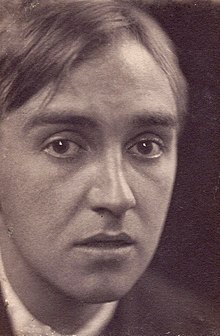Herbert Charles Pollitt
Herbert Charles Pollitt | |
|---|---|
 Portrait by Frederick H. Evans | |
| Born | July 20, 1871 Kendal, Westmorland |
| Died | August 10, 1942 (aged 71)[1] |
| Nationality | British |
| Alma mater | Trinity College, Cambridge |
| Military career | |
| Allegiance | |
| Service/ | |
| Years of service | 1914–1919 |
| Rank | Lance corporal |
| Unit | Royal Army Medical Corps |
| Battles/wars | World War I |
Herbert Charles Pollitt (July 20, 1871 – 1942), also known as Jerome Pollitt, was a patron of the arts and on-stage female impersonator who performed as Diane de Rougy (an homage to
Early life and education
Pollitt was the son of Charles Pollitt, the proprietor of The Westmorland Gazette and his wife, Jane. He attended Heversham school, then went on to Trinity College, Cambridge in 1889.[1] He gained his BA in 1892 and his MA in 1896.[2]
At Cambridge, he became president of
Diane de Rougy

The name of Pollitt's female alter-ego, Diane de Rougy, was inspired by Liane de Pougy, a vedette at the Folies Bergère who also had a reputation as one of Paris's most beautiful and notorious courtesans.[2] In performance, however, de Rougy's noted scarf-dancing was more like that of the American dancer Loie Fuller.[2][5]
As the Footlights were largely a masculine establishment, female impersonation was not uncommon, but de Rougy became particularly renowned for her performances and as much a local Cambridge celebrity as Pollitt himself.[2][6] She danced in two plays by Arthur Pilkington Shaw for Footlights, and it was claimed that her performances made women jealous.[2] In 1894, Frederick Hollyer exhibited a photographic portrait of de Rougy at the London Photographic Salon.[4]
As patron

Pollitt was a close friend of Aubrey Beardsley and became a collector of his art alongside other examples of erotica. He was also close to Leonard Smithers, Beardsley's publisher, from whom he purchased pornography for his collection. In his last letter, written on his deathbed, Beardsley begged Smithers and Pollitt to destroy all his erotic drawings and work, a request which both men ignored.[5][2]
Pollitt was also a collector and sometime patron of
Personal life
In October 1897, following his return to Footlights to perform as Diane de Rougy, Pollitt met Aleister Crowley, and the two swiftly entered into a relationship.[2][3] Crowley wrote that "I lived with Pollitt as his wife for some six months and he made a poet out of me."[2] The relationship ultimately failed through Pollitt's unwillingness to take part in Crowley's interest in mysticism.[2] This led to a quarrel, in which Crowley informed Pollitt that he did not fit into his plans for his life. Crowley quickly regretted the break-up, but they did not reconcile, and an accidental snub on Bond Street ultimately estranged Pollitt from his former lover.[2] Crowley remained attached to Pollitt, who inspired a number of sonnets and other poems, and immortalized him in his 1910 book on homosexual love, The Scented Garden of Abdullah the Satirist of Shiraz.[2][8] Finally, in his autobiography The Confessions of Aleister Crowley, he recalled the end of the relationship as a "lifelong regret."[2]
The exact nature of Pollitt's relationship with Beardsley is unclear, although the two men shared a keen interest in erotica and possibly transvestism. Beardsley referred to Pollitt as "My best good friend," and created a bookplate specially for him that seemed to echo Pollitt's vision of his female alter-ego.[5] Pollitt also sent risqué photographs of himself to their mutual friend Oscar Wilde.[5]
Later life
In 1901 Pollitt was living in
In popular culture
In
The Babe was a cynical old gentleman of twenty years of age, who played the banjo charmingly. In his less genial moments he spoke querulously of the monotony of the services of the Church of England, and of the hope-less respectability of M. Zola. His particular forte was dinner parties for six, skirt dancing and acting, and the performances of the duties of half-back at Rugby football. His dinner parties were selected with the utmost carelessness, his usual plan being to ask the first five people he met, provided he did not know them too intimately. With a wig of fair hair, hardly any rouge, and an ingenue dress, he was the image of Vesta Collins,[9] and that graceful young lady might have practised before him, as before a mirror... The furniture of his rooms was as various and as diverse as his accomplishments. Several of Mr. Aubrey Beardsley's illustrations from
Mr. Sponge's Sporting Tour, and Miss Marie Corelli's Barabbas.[10]
References
- ^ a b "Pollitt, Herbert Charles". ACAD A Cambridge Alumni Database.
- ^ ISBN 9781583945766.
- ^ ISBN 9780199863099.
- ^ a b c d e f MacDonald, Margaret. "Biography: Herbert Charles Jerome Pollitt, 1871–1942". Whistler Etchings: A Catalogue Raisonné. University of Glasgow. Retrieved 20 July 2017.
- ^ ISBN 9780802036629.
- ISBN 9781466875265.
- ^ "Whistler's portraits of H.C. Pollitt in the Art Institute of Chicago". The Art Institute of Chicago. Art Institute of Chicago. Retrieved 20 July 2017.
- ISBN 9780199863099.
- ^ Benson's amalgam of variety stars Vesta Tilley and Lottie Collins.
- ^ Benson, E. F. (1896). The Babe, B.A.: Being the uneventful history of a young gentleman at Cambridge university. New York: G.P. Putnam's Sons.
